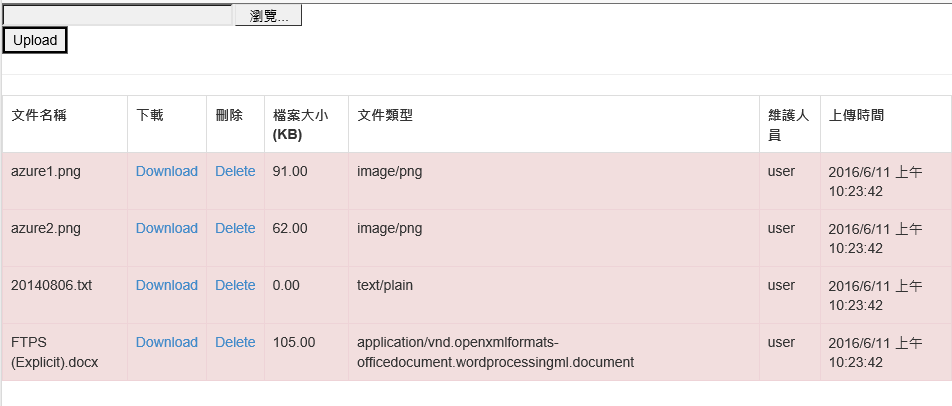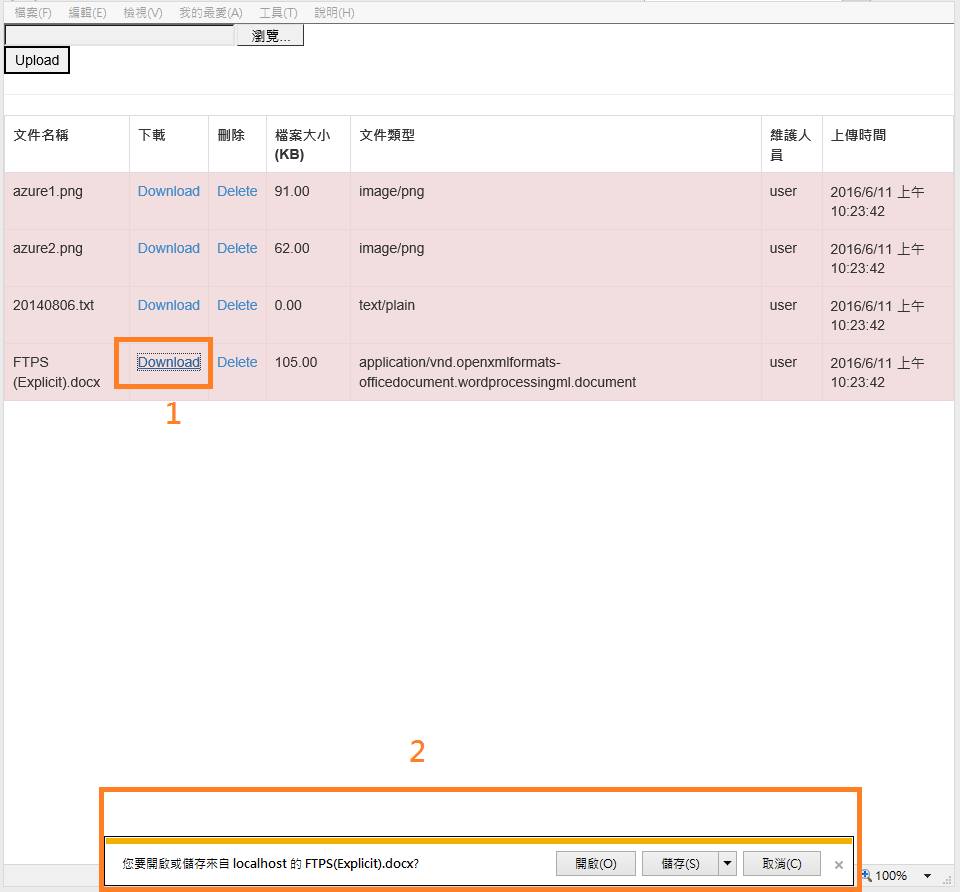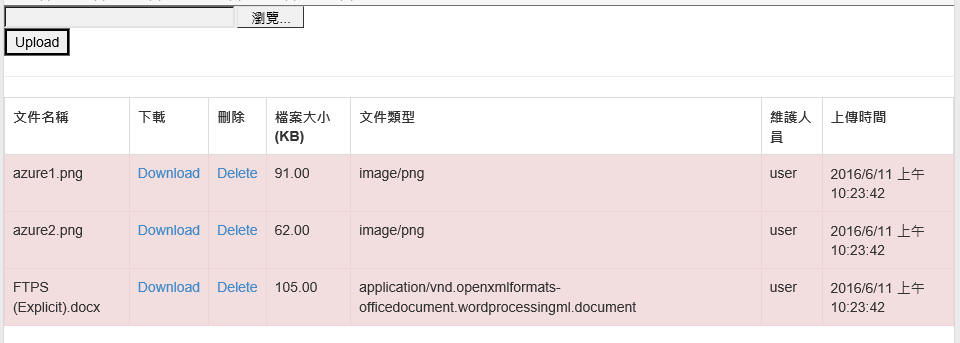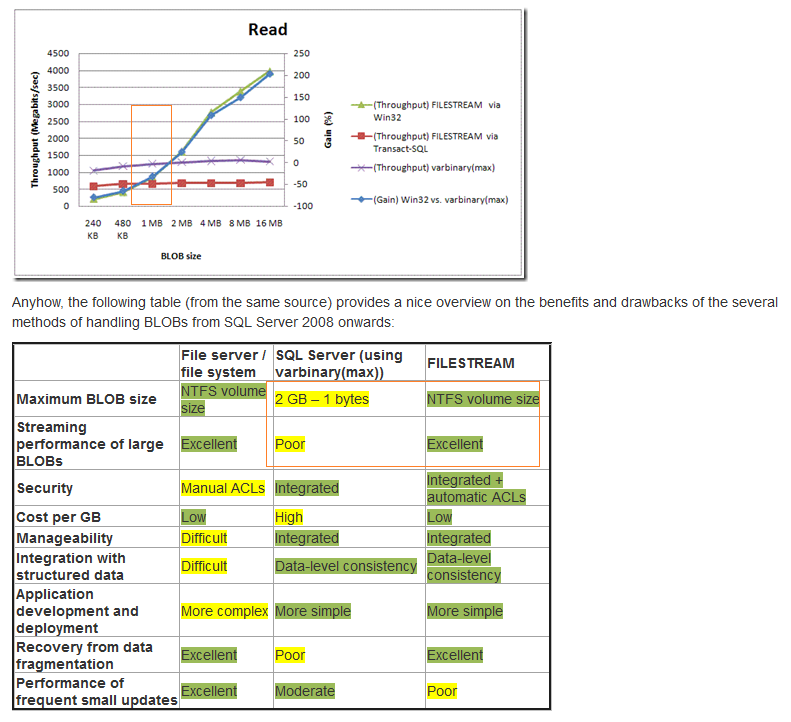最近專案中,使用者有大量小型文件型檔案(每個約1MB以內)要上傳到資料庫的需求,這篇先筆記Varbinary步驟:
- Table ([varbinary](max)) Binary Large Objects (BLOBs) + ADO.NET SqlCommand
- FileStream
- FileTable
原本其他成員打算上傳到網站目錄中,但和PM考慮到日後管理及資料封存問題,於是改變需求希望儲存到資料庫中。
因為上傳檔案不大,這次先筆記二進位儲存(varbinary),待會筆記SQL Server 2008功能filestream。
1.首先建立儲存文件檔案的資料表:
順道增加檔案資訊、檔案名稱、檔案大小等資訊。
CREATE TABLE [dbo].[Document](
[GUID] [int] IDENTITY(1,1) NOT NULL,
[CONTENT_TYPE] [nvarchar](100) NULL,
[FILE_NAME] [nvarchar](50) NULL,
[DATA] [varbinary](max) NULL,
[SIZE] [numeric](13, 2) NULL,
[MNT_USER] [varchar](20) NULL,
[MNT_DT] [datetime] NULL
) ON [PRIMARY] TEXTIMAGE_ON [PRIMARY]
GUI:

2.新增Web 表單並將需求的控制項拖曳進來,並預寫Server Side會提供的Method
- 控制項:FileUpload、Button及Gridview
- Event Method: Upload()、Gridview item Onclick=Downloadfile()、DeleteFile()
<%@ Page Language="C#" AutoEventWireup="true" CodeBehind="FileUploadToDb.aspx.cs" Inherits="WebApplication1.FileUploadToDb" %>
<!DOCTYPE html>
<html xmlns="http://www.w3.org/1999/xhtml">
<head runat="server">
<meta http-equiv="Content-Type" content="text/html; charset=utf-8" />
<title></title>
<link href="Content/bootstrap.min.css" rel="stylesheet" />
</head>
<body>
<form id="form1" runat="server">
<div>
<asp:FileUpload ID="FileUpload1" runat="server" Width="300px" />
<asp:Button ID="btnUpload" runat="server" Text="Upload" OnClick="Upload" />
<hr />
<asp:GridView ID="gdvData" runat="server" CssClass="table table-hover table-bordered" OnRowDataBound="gdvData_RowDataBound"
AutoGenerateColumns="false">
<Columns>
<asp:BoundField DataField="FILE_NAME" HeaderText="文件名稱" />
<asp:TemplateField ItemStyle-HorizontalAlign="Center" HeaderText="下載">
<ItemTemplate>
<asp:LinkButton ID="lnkDownload" runat="server" Text="Download" OnClick="DownloadFile"
CommandArgument='<%# Eval("GUID") %>'></asp:LinkButton>
</ItemTemplate>
</asp:TemplateField>
<asp:TemplateField ItemStyle-HorizontalAlign="Center" HeaderText="刪除">
<ItemTemplate>
<asp:LinkButton ID="lnkDelete" runat="server" Text="Delete" OnClick="DeleteFile"
CommandArgument='<%# Eval("GUID") %>'></asp:LinkButton>
</ItemTemplate>
</asp:TemplateField>
<asp:BoundField DataField="SIZE" HeaderText="檔案大小(KB)" />
<asp:BoundField DataField="CONTENT_TYPE" HeaderText="文件類型" />
<asp:BoundField DataField="MNT_USER" HeaderText="維護人員" />
<asp:BoundField DataField="MNT_DT" HeaderText="上傳時間" />
</Columns>
</asp:GridView>
</div>
</form>
</body>
</html>
3.撰寫Server Side程式,這邊先寫檔案上傳
將檔案讀入二進位資料byte[]後,直接作為ADO.NET SqlCommand 參數輸入。
protected void Upload(object sender, EventArgs e)
{
string filename = Path.GetFileName(FileUpload1.PostedFile.FileName);
string contentType = FileUpload1.PostedFile.ContentType;
using (Stream fs = FileUpload1.PostedFile.InputStream)
{
using (BinaryReader br = new BinaryReader(fs))
{
byte[] bytes = br.ReadBytes((Int32)fs.Length);
string constr = ConfigurationManager.ConnectionStrings["CN"].ConnectionString;
using (SqlConnection con = new SqlConnection(constr))
{
string query = "insert into Document values (@CONTENT_TYPE,@FILE_NAME,@DATA,@SIZE,@MNT_USER,@MNT_DT)";
using (SqlCommand cmd = new SqlCommand(query))
{
cmd.Connection = con;
cmd.Parameters.AddWithValue("@CONTENT_TYPE", contentType);
cmd.Parameters.AddWithValue("@FILE_NAME", filename);
cmd.Parameters.Add("@SIZE", SqlDbType.Decimal);
cmd.Parameters["@SIZE"].Value = Convert.ToDecimal(bytes.Length / 1024);
cmd.Parameters.AddWithValue("@MNT_USER", "User");
cmd.Parameters.AddWithValue("@MNT_DT", DateTime.Now);
cmd.Parameters.AddWithValue("@DATA", bytes);
con.Open();
cmd.ExecuteNonQuery();
}
}
}
}
Response.Redirect(Request.Url.AbsoluteUri);
}
4.接著把Server Side程式碼其他部分補完
Gridview查詢、Gridview css、下載、刪除事件等
using System;
using System.Collections.Generic;
using System.Configuration;
using System.Data;
using System.Data.SqlClient;
using System.IO;
using System.Linq;
using System.Web;
using System.Web.UI;
using System.Web.UI.WebControls;
namespace WebApplication1
{
public partial class FileUploadToDb : System.Web.UI.Page
{
protected void Page_Load(object sender, EventArgs e)
{
if (!IsPostBack)
{
loadGridData();
}
}
private void loadGridData()
{
string constr = ConfigurationManager.ConnectionStrings["CN"].ConnectionString;
using (SqlConnection con = new SqlConnection(constr))
{
using (SqlCommand cmd = new SqlCommand())
{
cmd.CommandText = "SELECT GUID,CONTENT_TYPE,FILE_NAME,SIZE,MNT_USER,MNT_DT FROM Document ";
cmd.Connection = con;
con.Open();
gdvData.DataSource = cmd.ExecuteReader();
gdvData.DataBind();
}
}
}
protected void DownloadFile(object sender, EventArgs e)
{
string GUID = (sender as LinkButton).CommandArgument;
byte[] bytes;
string fileName, contentType;
string constr = ConfigurationManager.ConnectionStrings["CN"].ConnectionString;
using (SqlConnection con = new SqlConnection(constr))
{
using (SqlCommand cmd = new SqlCommand())
{
cmd.CommandText = "select * from Document where GUID=@GUID";
cmd.Parameters.AddWithValue("@GUID", GUID);
cmd.Connection = con;
con.Open();
using (SqlDataReader sdr = cmd.ExecuteReader())
{
sdr.Read();
bytes = (byte[])sdr["Data"];
contentType = sdr["CONTENT_TYPE"].ToString();
fileName = sdr["FILE_NAME"].ToString();
}
}
}
Response.Clear();
Response.Buffer = true;
Response.Charset = "";
Response.Cache.SetCacheability(HttpCacheability.NoCache);
Response.ContentType = contentType;
Response.AppendHeader("Content-Disposition", "attachment; filename=" + fileName);
Response.BinaryWrite(bytes);
Response.Flush();
Response.End();
}
protected void DeleteFile(object sender, EventArgs e)
{
string GUID = (sender as LinkButton).CommandArgument;
string constr = ConfigurationManager.ConnectionStrings["CN"].ConnectionString;
using (SqlConnection con = new SqlConnection(constr))
{
using (SqlCommand cmd = new SqlCommand())
{
cmd.CommandText = "Delete Document where GUID=@GUID";
cmd.Parameters.AddWithValue("@GUID", GUID);
cmd.Connection = con;
con.Open();
cmd.ExecuteNonQuery();
}
}
Response.Redirect(Request.Url.AbsoluteUri);
}
protected void gdvData_RowDataBound(object sender, GridViewRowEventArgs e)
{
if (e.Row.RowType == DataControlRowType.DataRow)
{
string FILE_NAME = Convert.ToString(e.Row.Cells[0].Text);
e.Row.CssClass = FILE_NAME.Contains("test") ? "success" : "danger";
}
}
}
}
上傳時將上傳檔的MIME內容類型紀錄下來,這樣下載時,就可以直接使用
Response.ContentType = contentType;
測試下載:

測試刪除20140806.txt:

小結:
- 使用Varbinary檔案大小有2G的限制
- 效能考慮: 資料清單執行查詢時,建議先不把二進位資料查詢出來,只查詢其他檔案資訊的欄位,等使用者真的要下載時再查。
- 如果平均檔案大小超過1MB,則可以考慮FILESTREAM。(以NTFS 檔案系統儲存檔案)

參考:
binary 和 varbinary (Transact-SQL)
Best Practices on FILESTREAM implementations